
The Russulales are an order of the Agaricomycetes,. According to the Dictionary of the Fungi, the order consists of 12 families, 80 genera, and 1767 species. According to Species Fungorum, the order contains 13 families, 117 genera, and 3,060 species.

The Agaricales are an order of fungi in the division Basidiomycota. As originally conceived, the order contained all the agarics, but subsequent research has shown that not all agarics are closely related and some belong in other orders, such as the Russulales and Boletales. Conversely, DNA research has also shown that many non-agarics, including some of the clavarioid fungi and gasteroid fungi belong within the Agaricales. The order has 46 extant families, more than 400 genera, and over 25,000 described species, along with six extinct genera known only from the fossil record. Species in the Agaricales range from the familiar Agaricus bisporus and the deadly Amanita virosa to the coral-like Clavaria zollingeri and bracket-like Fistulina hepatica.
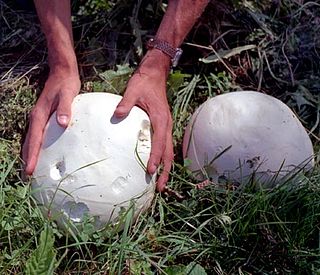
The Lycoperdales are a now outdated order of fungi. The order included some well-known types such as the giant puffball, the earthstars, and other tuberous fungi. They were defined as having epigeous basidiomes, a hymenium present, one to three layers in the peridium, powdery gleba, and brown spores.

The Suillaceae are a family of fungi in the order Boletales, containing the boletus-like Suillus, the small truffle-like Truncocolumella, as well as the monotypic genus Psiloboletinus. As of 2008, there are 54 species in the family. Gastrosuillus, once considered a distinct genus, has been shown with molecular analysis to be a recent evolutionary derivative of Suillus. Fuscoboletinus, described by Pomerleau and Smith in 1962, has also been subsumed into Suillus.
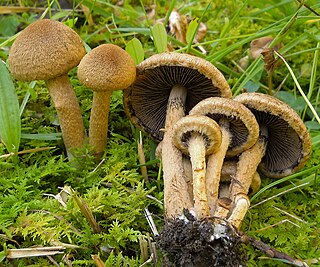
Lacrymaria is a genus of fungi in the family Psathyrellaceae. A 2008 estimate placed 14 species in the widespread genus.
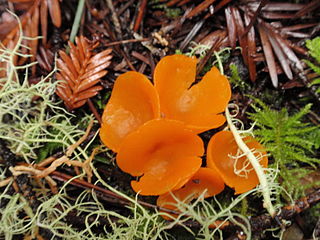
Sowerbyella is a genus of fungi in the family Pyronemataceae. The genus has a widespread distribution, and contains 17 species found mostly in Europe and China.

The Mycenaceae are a family of fungi in the order Agaricales. According to the Dictionary of the Fungi, the family contains 10 genera and 705 species. This is one of several families that were separated from the Tricholomataceae as a result of phylogenetic analyses. Taxa in the Mycenaceae are saprobic, have a cosmopolitan distribution, and are found in almost all ecological zones. The family was circumscribed by Caspar van Overeem in 1926.
Scytalidium is a genus of fungi in the Helotiales order. The relationship of this taxon to other taxa within the order is unknown, and it has not yet been placed with certainty into any family. This genus of anamorphic fungi has a widespread distribution and contains 18 species. Scytalidium dimidiatum causes onychomycosis in tea leaf pluckers.

Collybia is a genus of mushrooms in the family Tricholomataceae. The genus has a widespread but rare distribution in northern temperate areas, and contains three species that grow on the decomposing remains of other mushrooms.

Physalacria is a genus of fungi in the family Physalacriaceae. The genus contains 30 species widely distributed in tropical regions of the Southern Hemisphere.
Secotium is a genus of fungi in the family Agaricaceae. The members of this genus are closely related to ordinary Agaricus mushrooms, but do not open out in the usual way; this has given rise to the term "secotioid" for such mushrooms in general. They are thought to form an evolutionary link between agarics and gasteroid fungi. Secotium is a widespread genus, with species that are predominantly found in warm and arid regions.
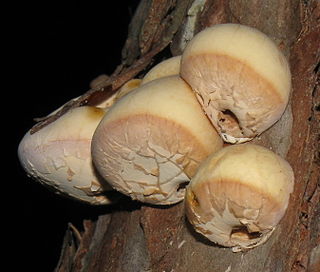
Cryptoporus is a genus of fungi in the family Polyporaceae. Originally described as a section of Polyporus by Charles Horton Peck in 1880, Cornelius Lott Shear made it a distinct genus in 1902. Cryptoporus contains two species, C. sinensis and the type C. volvatus, found in southeast Asia and North America, respectively. C. sinensis is morphologically indistinguishable from C. volvatus except for its smaller spores (7.5–10 by 4–5 μm compared to 10–12.5 by 5–6 μm. The generic name combines the Ancient Greek words κρυπτός and πόρος.

Spongipellis is a genus of fungi in the family Polyporaceae. The genus is widely distributed and contains ten species. The genus was circumscribed by French mycologist Narcisse Théophile Patouillard in 1887. The genus name combines the Latin words spongia ("sponge") and pellis ("skin").

Paragyrodon is a genus of fungi in the family Paxillaceae. It is a monotypic genus, containing the single species Paragyrodon sphaerosporus. Paragyrodon was circumscribed by Rolf Singer in 1942.
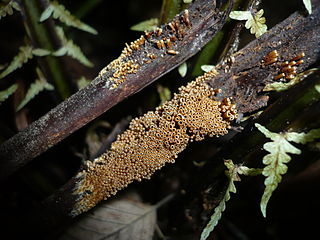
Woldmaria is a fungal genus in the family Niaceae. The genus is monotypic, containing the single species Woldmaria filicina, found in Europe and North America. Woldmaria was described by William Bridge Cooke in 1961, with Woldmaria crocea as the type species; it was subsequently moved into synonymy with W. filicina.
Urceolaria is a genus of fungi in the Pezizales order. The relationship of this taxon to other taxa within the order is unknown, and it has not yet been placed with certainty into any family. The genus was described by the German mycologist Hermann Friedrich Bonorden in 1851. According to the Dictionary of the Fungi, the genus contains about 100 species.
Neopaxillus is a genus of fungi in the family Crepidotaceae. According to the Dictionary of the Fungi, the family contains five species found in Central and South America; a sixth, N. dominicanus, was reported in 2011. It was formerly considered to belong in the family Serpulaceae in the order Boletales, but molecular analysis showed that Neopaxillus is better placed in the Agaricales as a sister group to Crepidotus.

Underwoodia is a genus of ascomycete fungi in the order Pezizales. The widespread genus contained many species, beforre they were transferred to the Geomorium genus. The genus, described by Charles Horton Peck in 1890, honors mycologist Lucien Marcus Underwood.
Phlebophyllum is a genus of fungi in the order Agaricales. It is incertae sedis with respect to familial placement within the order. The genus is monotypic, containing the single species Phlebophyllum vitellinum, discovered in Gabon and reported as new to science by mycologist Roger Heim in 1969.
Endoperplexa is a genus of fungi of uncertain familial placement in the order Auriculariales. The Dictionary of the Fungi report four species, but an additional two species have since been described or transferred into the genus.














